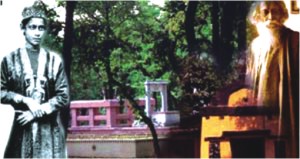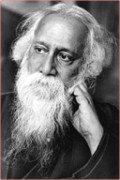| Travelogue
Shantiniketan: Tagore's Abode of Peace
Mohammad Shahidul Islam & Sadeka Sultana
 William Wordsworth's worthy words: ''Poetry is the spontaneous overflow of powerful feelings. It takes its origin from emotion recollected in tranquility'' are very much applicable in this present composition. Why else should we go weaving a travelogue? Albeit this is not a poem but the aim is poetic, a tribute to Shantiniketan. We intended to write something on the tour, and thus never missed taking notes. We can still recollect “Yatra visvam bhavatyekanidam (Vedic text)“where the world makes home in a single nest” lured one day from our 10 day tour of West Bengal. We had not been fortunate enough like many art and culture loving Bangladeshis in Shantiniketan, but what we discovered and learned in a single day would keep showing us the way to hymn over Rabindranath Tagore, poet, writer, painter, musician, educationist, Nobel laureate. William Wordsworth's worthy words: ''Poetry is the spontaneous overflow of powerful feelings. It takes its origin from emotion recollected in tranquility'' are very much applicable in this present composition. Why else should we go weaving a travelogue? Albeit this is not a poem but the aim is poetic, a tribute to Shantiniketan. We intended to write something on the tour, and thus never missed taking notes. We can still recollect “Yatra visvam bhavatyekanidam (Vedic text)“where the world makes home in a single nest” lured one day from our 10 day tour of West Bengal. We had not been fortunate enough like many art and culture loving Bangladeshis in Shantiniketan, but what we discovered and learned in a single day would keep showing us the way to hymn over Rabindranath Tagore, poet, writer, painter, musician, educationist, Nobel laureate.
 The passage to Shantiniketon is simply superb. It is about 160 km by road from Kolkata. The nearest railway station is Bolpur on the Eastern Railway. The place can be reached in a little over two hours from Kolkata by train. Luckily we came across a man from Bolpur named Golam Hossain Chowdhury at the Howrah Railway station. He accompanied us all the way, until our boarding at Chhaya Bithi, a renowned lodging of the locality, was confirmed. Later we came to know that there was a guesthouse in the Shantiniketan campus. Anyway, the room service of Chhaya Bithi impressed us a lot. The experience on board Howrah-Bolpur Shantiniketan Express was really amazing. Managing seats is not easy, as the last trip of the day is always loaded with passengers. Mr. Chowdhury arranged seats for us when he got to know that we are from Bangladesh. He told us that his brother-in-law lives in Dhaka, and is working in HSBC. We were enjoying the conversations of the passengers. The people are very much akin to Bangladeshis but the phonetics, language, attitude and culture seemed a bit different. The passage to Shantiniketon is simply superb. It is about 160 km by road from Kolkata. The nearest railway station is Bolpur on the Eastern Railway. The place can be reached in a little over two hours from Kolkata by train. Luckily we came across a man from Bolpur named Golam Hossain Chowdhury at the Howrah Railway station. He accompanied us all the way, until our boarding at Chhaya Bithi, a renowned lodging of the locality, was confirmed. Later we came to know that there was a guesthouse in the Shantiniketan campus. Anyway, the room service of Chhaya Bithi impressed us a lot. The experience on board Howrah-Bolpur Shantiniketan Express was really amazing. Managing seats is not easy, as the last trip of the day is always loaded with passengers. Mr. Chowdhury arranged seats for us when he got to know that we are from Bangladesh. He told us that his brother-in-law lives in Dhaka, and is working in HSBC. We were enjoying the conversations of the passengers. The people are very much akin to Bangladeshis but the phonetics, language, attitude and culture seemed a bit different.
We reached Bolpur station in the evening. The sun had already set and the surrounding was dark. We were looking for Rickshaw. The pullers were trying to draw the passengers' attention. We responded to one who assisted us to lift our luggage. We felt a bit relaxed once we had managed a vehicle. We started to enjoy the art and culture of Shantiniketan on the way to our destination. We found billboards and posters in Bengali language with different fonts, clubs, cultural organizations, Banks, firms, rural shopping centers, tea stalls, cooperatives etc. We continued conversation with the puller. He seemed a fan of Tagore and seemed to know a lot about Shantiniketan. One interesting thing we heard was the hand horn of the Rickshaw, instead of hand bells like those in Bangladesh.
 The people looked simple, common and proud to be from Bolpur where chic, cultural people visit even once in a lifetime. As it is a very small outskirt, we again happened to meet Mr. Chowdhury, who had a shoe shop near our lodge. He introduced us to Mr. Babu, the manager and owner of the lodge. We had a room with balcony that was attached to Bolpur stadium. From the lodge, the dreamy Shantiniketon could be reached on foot. We had been excited to visit Shantiniketan in the morning. The people looked simple, common and proud to be from Bolpur where chic, cultural people visit even once in a lifetime. As it is a very small outskirt, we again happened to meet Mr. Chowdhury, who had a shoe shop near our lodge. He introduced us to Mr. Babu, the manager and owner of the lodge. We had a room with balcony that was attached to Bolpur stadium. From the lodge, the dreamy Shantiniketon could be reached on foot. We had been excited to visit Shantiniketan in the morning.
It was winter at the time. The wind was cold and unbearable at night and early mornings. The daytime weather was soothing though. The morning was all misty. From the balcony we projected our sights to the far away range of hamlets. It hallmarked the reminiscent village of anyone of any country. We saw crowd and players in the stadium where no standard galleries were provided. It looked like a typical high school field in Bangladesh. The green grass of Walt Whitman spread over the field and echoed: “ The grass is greener on the other side”.
We set out at 8:30 in the morning. We first came to feast our eyes on the land in broad daylight. Wow! What a sublime nature! Wherever we looked, our eyes were caught in the greeneries. Vegetation and red clay roads appeased the thirst of nature. Keats's nightingale might have been found there in the dense vegetation. Here people do not conserve nature rather nature conserves people. We looked for a restaurant to break our fast so we could enjoy the culinary of locale and found one without much effort. A family ran the restaurant, and the children were helping the parents in preparing breakfast. The care they bestowed upon us  was simply unique. was simply unique.
We decided to walk on foot to Shantiniketan. Already visitors were slowly gathering in Shantiniketan. We had been very fortunate to get entry into Shantiniketan, as it was a holiday. We did not know that the authority maintains visiting hours as follows
Winter: - 1400 to 1630 hours
Summer: - 1430 to 1730 hours.
During vacations: - 0730 to 1100 hours
 We entered the campus proudly. Once again the nature captivated our soul. Couple of months ago, Tagore's Nobel Prize was stolen; hence the tight security was even tighter. We loved every corner of the establishment: the Uttarayan complex where the poet lived consists of several buildings such as Udayana, Konark, Shyamali, Punascha and Udichi. These reflect the architectural genius of the poet's son, the late Rathindranath Tagore. In addition there are the Kala Bhavan (College of Fine Arts and Crafts), Sangit Bhavan (College of Music and Dance), Vidya Bhavan (College of Humanities), Siksha Bhavan (College of Science), Vinaya Bhavan (Teacher's Training College), Cheena Bhavan and Hindi Bhavan. The Rabindra Bhavan, a Research Center and Museum where the poet's personal belongings, paintings and various editions of his works are exhibited, should be dubbed a rare achievement. We entered the campus proudly. Once again the nature captivated our soul. Couple of months ago, Tagore's Nobel Prize was stolen; hence the tight security was even tighter. We loved every corner of the establishment: the Uttarayan complex where the poet lived consists of several buildings such as Udayana, Konark, Shyamali, Punascha and Udichi. These reflect the architectural genius of the poet's son, the late Rathindranath Tagore. In addition there are the Kala Bhavan (College of Fine Arts and Crafts), Sangit Bhavan (College of Music and Dance), Vidya Bhavan (College of Humanities), Siksha Bhavan (College of Science), Vinaya Bhavan (Teacher's Training College), Cheena Bhavan and Hindi Bhavan. The Rabindra Bhavan, a Research Center and Museum where the poet's personal belongings, paintings and various editions of his works are exhibited, should be dubbed a rare achievement.
 We had a chance to stand on the stage of Shantiniketan where functions and ceremonies are held. We were happy to know that some eminent sons of Bangladesh have achieved Doctorate degrees and cultural awards from this stage. The environment seemed omnipresent in one's consciousness, and becomes a part of one's being. We were told that the Santiniketan environment has changed, grown and evolved with its community. It was always the objective in Santiniketan that learning would be a part of life's natural growth. The first step towards this objective was to establish in the child a sense of oneness with nature. A child has to be aware of his surroundings - the trees, birds and animals around him. We had a chance to stand on the stage of Shantiniketan where functions and ceremonies are held. We were happy to know that some eminent sons of Bangladesh have achieved Doctorate degrees and cultural awards from this stage. The environment seemed omnipresent in one's consciousness, and becomes a part of one's being. We were told that the Santiniketan environment has changed, grown and evolved with its community. It was always the objective in Santiniketan that learning would be a part of life's natural growth. The first step towards this objective was to establish in the child a sense of oneness with nature. A child has to be aware of his surroundings - the trees, birds and animals around him.
 The mind is deprived if one is indifferent to the world outside. Santiniketan today is an authentic botanists' paradise. Plants, trees, creepers and orchids from various parts of India and abroad have flourished in this once semi-desert. Rabindranath himself took a deep interest in planting trees. The mind is deprived if one is indifferent to the world outside. Santiniketan today is an authentic botanists' paradise. Plants, trees, creepers and orchids from various parts of India and abroad have flourished in this once semi-desert. Rabindranath himself took a deep interest in planting trees.
Visit to Kopai River few kilometers from Shantiniketan was enthralling for the visitors of Shantiniketan. We satiated our heart watching the sun set on the River Kopai in the evening at the backdrop of the forests. A beautiful day at Shantinekatan completely obsessed us with the opium of beauty. We looked beyond the windows but saw nothing except a landscape with red laterite and meadows of lush green paddy fields, where the reflection of Bengali cultural heritage has been amassed and drawn.
Mohammad Shahidul Islam,
Faculty,
NHTTI, Bangladesh Parjatan Corporation
Sadeka Sultana
Faculty,
Directorate of Primary and Mass Education
Copyright
(R) thedailystar.net 2007 |
